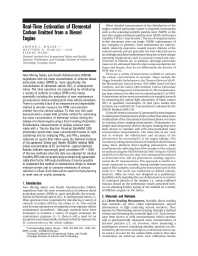Mining Publication: Real-Time Estimation of Elemental Carbon Emitted from a Diesel Engine
Original creation date: August 2007
New Mining Safety and Health Administration (MSHA) regulations limit the mass concentration of airborne diesel particulate matter (DPM) or, more specifically, the concentration of elemental carbon (EC in underground mines. The mine operators are responding by introducing a variety of controls to reduce DPM in the mines, potentially including the evaluation of new maintenance procedures to reduce underground mine vehicle emissions. There is currently a lack of an inexpensive and dependable method to directly measure the DPM concentration emitted from the vehicle tailpipe. To that end, this work demonstrated a simple field portable method for estimating the mass concentration of elemental carbon exiting the tailpipe of a diesel engine using a direct reading photometer. Simultaneous measurements of tailpipe exhaust were made with a Thermo Electron Personal DataRAM 1200 photometer (particulate mass concentration based on light scattering) and by analyzing PM2.5 and PM1.0 samples collected on quartz fiber filters using the National Institute of Occupational Safety and Health (NIOSH) method 5040 (mass concentration of EC via thermal-optical method). Results indicate surprisingly good correlation (R2 = 0.97) of the two methods when the data are adjusted for relative humidity (RH) and corrected using an empirically generated calibration factor. Although preliminary, it may be possible to implement this method in maintenance shops to monitor emission trends and to compare emissions of various vehicles in a fleet. Such data will be useful for fleet planning to meet new air quality standards.
Authors: AL Miller, MC Habjan, KH Park
Peer Reviewed Journal Article - August 2007
NIOSHTIC2 Number: 20032593
Environ Sci Technol 2007 Aug; 41(16):5783-5788
See Also
- Aerosols Emitted in Underground Mine Air by Diesel Engine Fueled with Biodiesel
- AQE - Air Quantity Estimator - 1.0.3
- A Computer Software Program that Estimates Air Quantity Requirements in Large Opening Stone Mines
- DEEP Project on Evaluation of Diesel Particulate Filters at Inco's Stobie Mine
- Diesel Aerosols and Gases in Underground Mines: Guide to Exposure Assessment and Control
- The Effectiveness of Selected Technologies in Controlling Diesel Emissions in an Underground Mine: Isolated Zone Study at Stillwater Mining Company's Nye Mine
- Effects of Diesel Exhaust Aftertreatment Devices on Concentrations and Size Distribution of Aerosols in Underground Mine Air
- The Effects of Water Emulsified Fuel on Diesel Particulate Matter Concentrations in Underground Mines
- Mutagenicity of Diesel Exhaust Particles from an Engine with Differing Exhaust After Treatments
- Technology News 514 - The Air Quantity Estimator (AQE): A New Computer Software Tool for Large-opening Mine Ventilation Planning
- Content source: National Institute for Occupational Safety and Health, Mining Program


 ShareCompartir
ShareCompartir
